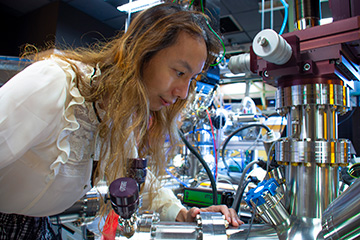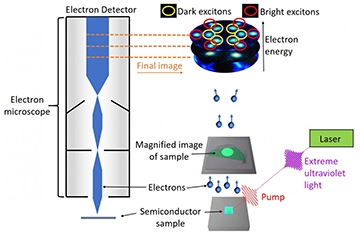
Michael Man, staff scientist in the OIST Femtosecond Spectroscopy Unit, loads a sample of the semiconductor material into the electron microscope. [Image: OIST]
Just as astronomers probe the mysteries of dark matter in the universe, scientists developing new optoelectronic materials have been studying the properties of excitons—quasiparticles consisting of an electron and electron hole bound together inside semiconductors. And just as dark matter is difficult to detect because it doesn’t interact with light, so-called dark excitons carry momentum but don’t interact with photons, putting them beyond the reach of most probes.
Now, researchers in Japan, India and the U.S. have invented a spectroscopic method to track the dynamics of both bright and dark excitons within a monolayer of semiconductor materials (Science, doi: 10.1126/science.aba1029). The study is yielding insights into the populations and dynamics of these types of excitons in 2D semiconductors.
Types of excitons
The team at Okinawa Institute of Science and Technology Graduate University (OIST), Japan, worked with a monoatomic layer of tungsten diselenide, a compound in the transition metal dichalcogenide family. Scientists are already familiar with the light absorption and photoluminescence exhibited by the bright excitons, which have no momentum.
The dark excitons, however, have electrons that are in different local conduction-band minima from the bright electrons. Dark excitons carry momentum and interact with bright excitons, but not with photons. Standard photoemission spectroscopy captures the dynamics of the bright excitons, but not their dark counterparts.
Microscopy revelations

An initial pump pulse of light excites electrons and generates excitons, followed by a second XUV pulse of light that kicks the electrons within excitons out of the material and into the vacuum of an electron microscope. The microscope then measures the energy and angle that the electrons left the material. [Image: OIST]
The OIST group tweaked the spectroscopy protocol to reveal both types of excitons. First, using a photoemission electron microscope, the researchers hit the tungsten diselenide sheet with pulses of visible light to stimulate the formation of excitons. Next, after a variable time delay (measured in picoseconds), they bombarded the semiconductor with ultrafast pulses of extreme ultraviolet light to knock electrons out of the thin sheet. Studying the sequence of images generated by the microscopy setup revealed the dynamics of both types of excitons.
Surprisingly, the experiments revealed more dark than light excitons, by a 2-to-1 margin. Phonon scattering results in the preferential conversion from light to dark excitons. The team’s time- and angle-resolved spectroscopic technique could open the door to new studies of quantum materials, both in monolayers and in bulk.
Researchers from the Indian Institute of Technology, India, the University of Texas at Austin, Stanford University, SLAC National Accelerator Laboratory and the University of Washington, all in the U.S., contributed to the study.
